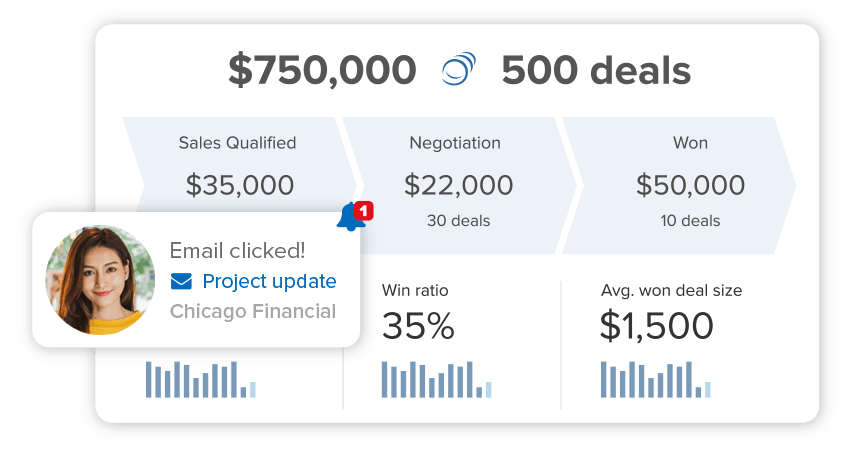New Case Study: How XpressConnect Personalizes Outreach to 70,000 Contacts in Pipeline CRM!
New Case Study: How XpressConnect Personalizes Outreach to 70,000 Contacts in Pipeline CRM!

Adopting CRM software can be a substantial investment. Are you getting the most out of it? Calculating your CRM’s ROI can help answer that question.
This guide explores what CRM ROI is, how to measure it, and best practices for maximizing it. By understanding your CRM’s ROI, you can quantify the impact, identify underutilized features, and make data-driven decisions to upgrade or explore alternative CRM solutions.

Free CRM Guide
CRM ROI, which stands for Customer Relationship Management Return on Investment, is a key metric used to evaluate a CRM’s efficiency and profitability. It compares the net income earned through improved customer relationships to the total costs of implementing and maintaining the CRM system over a specific period.
The ROI of CRM is typically expressed in percentages. Principally, the higher the ROI, the more profitable your business is using CRM. Here’s a breakdown of what different ROI ranges signify:
To measure the ROI of CRM, you first need to calculate CRM expenses and net sales revenues.
The total costs of adopting your CRM include:
Generally, lower overall costs (e.g., a competitive price tag and a short learning curve) often translate to a higher CRM ROI.
Use this formula to calculate the net sales revenue.
Net revenue = Total revenue – Total operating expenses
Total Operating Expenses include salaries, rent, utilities, marketing expenses, and other related expenses.
That said, Net Revenue might not always capture the full picture of your CRM’s impact on your unique sales challenges. For instance, if your main challenge is lead conversion, a more specific metric, like the improvement in conversion rate after CRM software implementation, would be valuable. This directly shows how CRM adoption has improved your ability to turn leads into paying customers.
To do this, calculate your ‘conversion rate’ with the following formula:
Conversion rate = Number of leads that moved to the next stage / Total initial number of leads x 100%
Other common sales metrics include:
Related: Learn more key sales metrics every sales rep should track in this blog.
Use the following formula to calculate CRM ROI:
CRM ROI = (Net revenue after CRM implementation – CRM costs) / CRM costs x 100%
Here’s a practical example of how it works. You spent $20,000 on new CRM software, and your net revenue is $100,000. In that case, your CRM ROI is:
CRM ROI = (100,000 – 20,000) / 20,000 x 100% = 400%.
400% CRM ROI means that for every dollar invested in the sales CRM software, you’ll get $4.00 back.
Unfortunately, there isn’t a one-size-fits-all answer for a ‘good’ CRM ROI. As long as the ROI is over 100%, you’re making money back on your investment. That said, some studies can help you gauge your CRM performance.
A 2014 study found that for every dollar spent, a company gets $8.71 back. In 2014, the rate increased by 1.5x yearly. So, generally speaking, if your CRM ROI is at least 871%, your CRM is a good investment.
Here are some questions to guide you.
For example, if you own an agency business and are looking to improve the sales process (such as accurate lead tracking and deal customization), choose CRM software with a strong sales solution like Pipeline CRM. We are one of the best CRM agencies on the market.
A CRM tool with sales automation features like adding recurring deals, suggesting ‘next step,’ and follow-up reminders increases productivity, allowing you to focus on more important business tasks.
One reason your CRM may not be the best investment is its growth limitation. You might start using the CRM when you’re just a small business. As your company grows, the CRM can’t accommodate all your needs, preventing you from unlocking your business’s full potential.
Pro tip: This free CRM handbook will help you choose the right CRM for your business.
Now, to get the most out of your CRM capabilities and investment, here are a few things you can do:
Provide continuous and practical training to your team, especially during the first few weeks of the CRM adoption. Tailor the material to use real-life data from your business. This will not only accelerate the onboarding phase but also help your team see firsthand the positive impact the CRM tool can have on their daily work.
Your CRM should represent your sales processes. Make some adjustments right from the start to ensure effective workflow. For instance, tailor the deal profile pages, create custom activities for easy sales tracking, create multiple sales pipelines for different sales needs, and give special permissions for specific users.
Related: Discover five key scenarios where multiple sales pipelines can unlock even greater success.
Some CRM tools offer advanced automation solutions to free up your time. These include:
Connect your CRM with tools you love. This eliminates errors and delays in manual data transfer and makes the CRM the only source of truth for all sales-related activities. Some common integrations include email marketing, contacts and calendars, task management, marketing automation, accounting, and phone solutions. Pipeline CRM, for instance, offers Mailchimp, QuickBooks, and CallRail integrations, among other popular sales and marketing integration options.
Set up lead assignment rules to minimize delay or unassigned leads. Combine this with automatic reminders and email drip campaigns to ensure each contact gets the attention it deserves and turns into paying customers.
Not all CRM tools are created equal. Calculate your CRM’s ROI to see its real value to your business.
Want to see the real impact of a powerful CRM? Pipeline CRM helped a manufacturing business slash its time-to-close by 42%! Discover their success stories here.
See How Pipeline CRM Can Work For You
sales@pipelinecrm.com
Site links